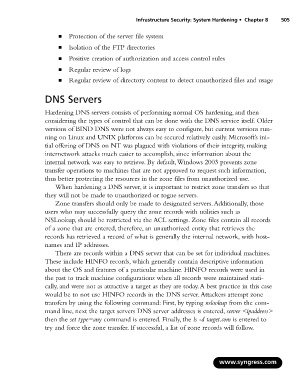Page 521 - StudyBook.pdf
P. 521
Infrastructure Security: System Hardening • Chapter 8 505
■ Protection of the server file system
■ Isolation of the FTP directories
■ Positive creation of authorization and access control rules
■ Regular review of logs
■ Regular review of directory content to detect unauthorized files and usage
DNS Servers
Hardening DNS servers consists of performing normal OS hardening, and then
considering the types of control that can be done with the DNS service itself. Older
versions of BIND DNS were not always easy to configure, but current versions run-
ning on Linux and UNIX platforms can be secured relatively easily. Microsoft’s ini-
tial offering of DNS on NT was plagued with violations of their integrity, making
internetwork attacks much easier to accomplish, since information about the
internal network was easy to retrieve. By default,Windows 2003 prevents zone
transfer operations to machines that are not approved to request such information,
thus better protecting the resources in the zone files from unauthorized use.
When hardening a DNS server, it is important to restrict zone transfers so that
they will not be made to unauthorized or rogue servers.
Zone transfers should only be made to designated servers.Additionally, those
users who may successfully query the zone records with utilities such as
NSLookup, should be restricted via the ACL settings. Zone files contain all records
of a zone that are entered, therefore, an unauthorized entity that retrieves the
records has retrieved a record of what is generally the internal network, with host-
names and IP addresses.
There are records within a DNS server that can be set for individual machines.
These include HINFO records, which generally contain descriptive information
about the OS and features of a particular machine. HINFO records were used in
the past to track machine configurations when all records were maintained stati-
cally, and were not as attractive a target as they are today.A best practice in this case
would be to not use HINFO records in the DNS server.Attackers attempt zone
transfers by using the following command: First, by typing nslookup from the com-
mand line, next the target servers DNS server addresses is entered, server <ipaddress>
then the set type=any command is entered. Finally, the ls -d target.com is entered to
try and force the zone transfer. If successful, a list of zone records will follow.
www.syngress.com

